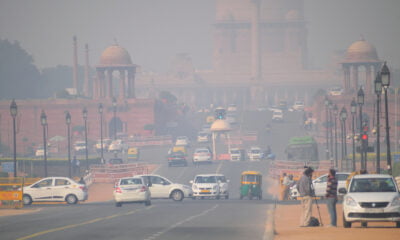

Economy
India’s Prime Minister Modi will shortly arrive in UK: Blue & Green coverage of India
In light of Indian PM Modi’s imminent arrival in the United Kingdom for a three-day visit, we look back at the last two months of Blue & Green coverage. India is the ninth largest economy in the world and the third highest carbon emissions, but is one of the lowest per head. The renewable opportunity for India is vast, but the world’s largest democracy has some ethical issues to address.
US$100 billion in new renewable investments power Indian energy transition
Investments worth over US$100 billion in the past eight months alone are driving an unprecedented shift to renewable energy in India, according to a major new report from the Institute for Energy Economics and Financial Analysis (IEEFA). Read more.
Indian authorities in new attempt to shut down Greenpeace India
Indian authorities have announced the cancellation of Greenpeace India’s legal registration – a move which marks an escalation in their attempts to shut down the organisation. Read more.
Indian power behemoth accepts winds of change
In further signs of the staggering pace of transformation in global energy markets, Indian power behemoth Reliance Power, one of the three largest private power groups in that country, is urgently seeking to change the fundamentals of its business strategy. Read more.
Nuclear and Renewables Will Drive India’s Cumulative Installed Capacity Beyond 600 GW by 2025
India’s cumulative installed capacity will more than double from 272.8 Gigawatts (GW) in 2014 to 609 GW by 2025, representing a Compound Annual Growth Rate (CAGR) of 7.3%, according to research and consulting firm GlobalData. Read more.
Analysis: India likely to far exceed emissions intensity target
The Indian Government is likely to overachieve its 2030 climate intensity target without having to implement any new policies, the Climate Action Tracker (CAT) said today. Read more.
India to curb greenhouse gas emissions 35 percent by 2030: reactions
By 2030 India’s climate actions (INDC) are to Reduce emission intensity by 33-35% compared to 2005, Produce 40 per cent of electricity from non-fossil fuel based energy, if international community helps, Create an additional carbon sink of 2.5 to 3 billion tonnes of CO2 equivalent through additional forest cover and Develop robust adaptation strategies for agriculture, water and health sectors. Here’s the reaction. Read more.


 Environment10 months ago
Environment10 months agoAre Polymer Banknotes: an Eco-Friendly Trend or a Groundswell?

 Environment11 months ago
Environment11 months agoEco-Friendly Home Improvements: Top 7 Upgrades for 2025

 Features9 months ago
Features9 months agoEco-Friendly Cryptocurrencies: Sustainable Investment Choices

 Features10 months ago
Features10 months agoEco-Friendly Crypto Traders Must Find the Right Exchange






























